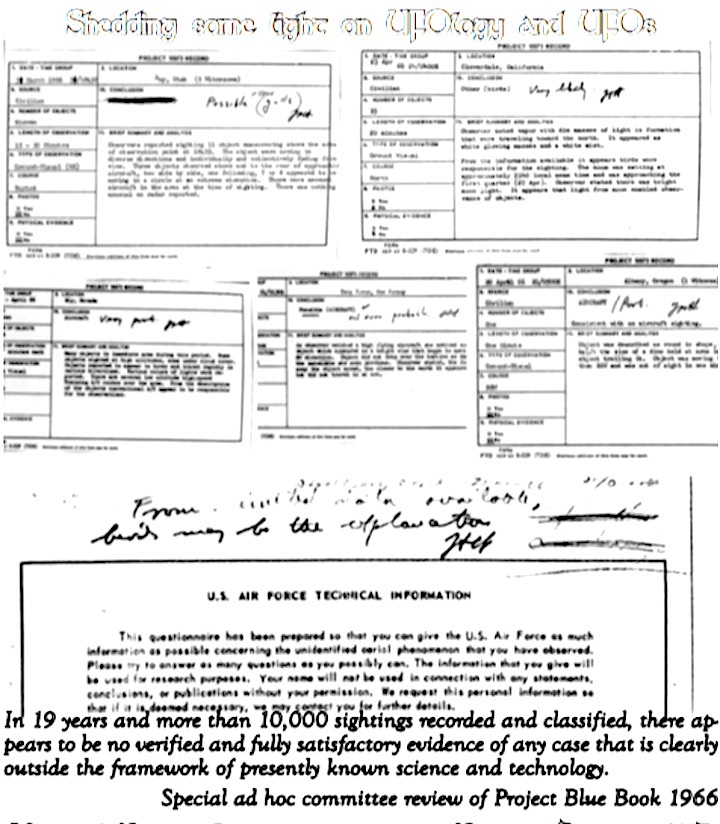
The Blue Book case files: UFO treasure or UFO trap?
The Blue Book system contains over 12,000 case les, which include anything from letters from the individuals, who made the sighting, to high level correspondence between various commands discussing the case itself. The electronic les one nds at fold 3 are informative but they are not perfect. Some events are missing and others have been led in the wrong folder. Despite this handicap, one can nd most of the case les and see what e ort, if any, was expended to investigate each report. I can’t say that I have examined every incident but, from what I have examined, I see that many of the them contain insu cient information and quite a few of the investigations were not very good.
Despite the lack of solid information that can be found in these les, some UFO proponents consider them a source of vital informa- tion that contains a great scienti c revelation. Brad Sparks has frequently supported this idea and recently stated:
no one has scienti cally sifted ALL of the 130,000 pages of BB les. You have no idea what is in there and I am telling you it is shocking...1
Exactly what does “scienti cally sifted” mean? The Center for UFO Studies (CUFOS), which was headed by Dr. J. Allen Hynek, per- formed a “scienti c sifting” in the 1970s. Instead of declaring that what they had found was earth shattering, they simply pointed out how many cases were unidenti ed and produced some statistics. Perhaps, Sparks’ wants a better sifting headed by UFO propo- nents with a more “positive attitude” .
The one item that is indisputable about the Blue Book les is that a certain residue of cases could not be explained. What is in dis- pute is the exact number of unexplained reports.
Possible, Probable, Identi ed
Many of the problems associated with Blue Book had to do with how the system worked. The sta at Blue Book was just a few people with an o cer in charge. They relied upon the UFO o cer at the local Air Force base, or members of the 4602nd Air In- telligence Service Squadron (AISS), to gather all the data and conduct an investigation, which was then forwarded to the Blue Book sta . The amount of information collected and degree of investigation was determined by these o cers. Some were diligent in the conduct of this duty and others were not. The end result is what we see in the Blue Book les. A hodgepodge of incidents that are often confusing, had missing details, and/or lacked adequate investigation.
Using the information they collected, the project Blue Book sta were tasked with the job of identifying what these sightings repre- sented. Over time, they discovered it was di cult to positively identify the source of a sighting based on the limited amount of data that was available. This resulted in Blue Book adopting a degree of certainty scale when identifying the source of the UFO report.
In the Blue Book les, there is the transcript of a brie ng that Captain Ruppelt gave to the Air Defense Command in March 1953. In that brie ng, Ruppelt explained how they determined the level of probability that the incident was explained
In breaking down these reports, we use several degrees of certainty under each category. We’ll take balloons, for example. We will classify them as a known balloon, a probable balloon, or a possible balloon. A known balloon means that we were de nitely able to correlate the facts of the sighting with the data on a balloon track and there is no doubt that the object was a balloon. Probably a balloon means that we were not able to correlate all the data, but there is no doubt in our minds but what the reported object was a balloon. A possible balloon is where we check the report with the balloon data and cannot nd a correlation yet we still believe the object was a balloon. This factor accounts for “lost” balloons, that is, balloons that may have developed slow leaks and oated great distances.2
This methodology could be expanded to astronomical, planes, or other objects. It was subjective but, when examining what the project was trying to accomplish, it was a valid attempt to classify these sightings using the data that was provided.
During the Battelle study, those investigating each case decided to use two levels of classi cation for those cases that were “iden- ti ed”.
All possible identi cations provided in the code system, except INSUFFICIENT INFORMATION and UNKNOWN, could be assigned accord- ing to two degrees of certainty, designated “Certain” and “doubtful”.
A “certain” identi cation indicated a minimum amount of doubt regarding the validity of the evaluation. By “rule of thumb” reasoning, the probability of the identi cation being correct was better than 95 per cent. A “doubtful” identi cation indicated that the choice was less positive, but that there was a better than even chance of being correct. 3
This was another subjective system used to help those evaluating the cases based on the limited data that was available. One might be able to consider the Battelle group’s classi cation of “doubtful” to be equivalent to Ruppelt’s version of “Possible”.
The scientists associated with The University of Colorado UFO project determined that it was not always possible to get a positive identi cation on the source of a UFO report. They came up with classi cation they referred to as “plausibly explained” :
Some investigators take the position that, where a plausible interpretation in terms of commonplace events can be made, then the UFO is regarded as having been identi ed. Others take the opposite view that an UFO cannot be regarded as having been given an ordinary identi cation unless there is complete and binding evidence amounting to certainty about the proposed identi cation... As a practical matter, we take the position that if an UFO report can be plausibly explained in ordinary terms, then we accept that explanation even though not enough evidence may be available to prove it beyond all doubt.4
Again, this is a subjective measure to classify UFO reports. Like Blue Book, they seemed willing to take a “probable” or, perhaps, “possible”, solution and declare it “identi ed”.
All this means is that cases that bear the labels of “probable” or “possible” can be considered explained to a certain degree. For ex- ample, If a case was considered a “possible” meteor, it was usually due to the fact that the witness description indicated a meteor ex- planation was likely but there was no con rming report that a bright meteor was seen by others at the time indicated (see page 27).
Blue Book’s attempts at classifying cases was subject to a lot of criticism from some UFO organizations and scientists, that had a personal belief that UFOs represented something unknown to science. They considered the use of “possible” and “probable” to be totally unsatisfactory.
Criticism of Blue Book’s e orts
Probably the biggest critic of Blue Book was Donald Keyhoe and NICAP. While they ran a negative publicity campaign on the USAF e ort, they also produced a document, which they referred to as their “Best evidence” for UFOs. While it is an interesting listing of UFO cases, quite a few of them were explained by Blue Book. I have also examined other reports in this collection, that were not in the Blue Book system, and found potential explanations for those as well. NICAP failed to achieve its goal of convincing people, outside of the UFO community, with this publication because they padded it with cases that were uncon rmed or could be explained.
While Keyhoe’s organization had some clout, Dr. James McDonald, a prominent atmospheric physicist, was a real driving force in criticism of Blue Book. He quickly took the side that UFO reports were probably observations of alien spacecraft and used his high pro le position to attack Blue Book every chance he could get. In 1967, Dr. McDonald stated:
At Bluebook the most outrageously unscienti c “explanations” were assigned to important sightings. Cases bearing not the slightest resemblance to feathered creatures were called “birds” and some of the most improbable “balloon” phenomena in all the history of ballooning can be found in the Bluebook les. “Astronomical” was tagged onto cases that are no more astronomical than ornitholog- ical, and so it went. The “percentage of unidenti ed” was, by the st of scienti cally untrained Bluebook o cers, steadily “reduced to a minimum.” And science be damned.5
It is important to point out the Dr. McDonald was quite critical of the Air Force in other areas and he created a lot of problems for Major Quintanilla and his boss at ATIC. In this statement, he made some claims that appear exaggerated. McDonald gives the false impression that birds, astronomical, and balloon were used incorrectly to explain a lot of cases. I am sure there were events where the explanations were wrong but, from what I have seen, this was not as widespread as McDonald implied. For instance, I exam- ined the “bird” explanations for 1964-1966. There were 21 cases labeled “birds” between 1964 and 1966. All could have been birds or ocks of birds. Dr. Hynek even agreed with some of these classi cations by initialing the record cards. There is little doubt that Blue Book made mistakes in some of their classi cations. However, McDonald’s reliance on eyewitness testimony as being highly accurate often incorrectly lead him to consider cases, like the Chiles-Whitted sighting, as being evidence of alien spaceships. The pendulum can swing both ways in these arguments.
Despite McDonald’s heavy handed approach, Blue Book still gave him full access to the les in their system. He used these les, along with NICAP’s versions of events, to create a list of “best cases” that he thought would withstand scienti c scrutiny. While he was capable of in uencing many UFOlogists, he was less successful in convincing his fellow scientists. Dr. Carl Sagan wrote the following about McDonald’s e orts:
In the middle 1960s I arranged for McDonald to present his best cases in a private meeting with leading physicists and astronomers who had not staked a claim on the UFO issue. Not only did he fail to convince them that we were being visited by extraterrestrials; he failed even to excite their interest. And this was a group with a very high wonder quotient. It was simply that where McDonald saw aliens, they saw much more prosaic explanations.6
Dr. Jaques Vallee, a French astronomer and UFO proponent, was also critical of Blue Book. His favorite target appeared to be Ser- geant Moody, who was charged with classifying cases in the mid-1960s:
At one time, I joked with Dr. Hynek, I said, “Look, I’m going to write a book called “The Universe According to Sgt. Moody” because it was a remarkable universe where meteors made 90 degree turns, Venus rose in the north, and all kinds of strange things happened”. Comets left depressions in the ground and all sorts of stu . They could explain anything. At one time, Allen Hynek went there and said what about such and such a case, what happened to it? Sgt. Moody said, Well, I have explained it. Oh, well, what was it? He said I’ve explained it as an unknown. As long as I had a statistical category this case was closed. I used to go berserk with that. I would say look, these are the cases you should be passing on to scientists, you should be studying. They said no, it was just an unknown and there’s only 2% unknown, so there’s no reason to be alarmed in any way.7
I nd Vallee’s claims about Moody’s ignorance to physical laws rather interesting because Vallee, Hynek, and McDonald believed that UFOs could defy the laws of physics. The di erence between the Blue Book sta and these scientists is that Blue Book felt these observations of objects performing exotic maneuvers were just inaccurate observations/reports. Based on what we know about eyewitness testimony and UFO reports, Blue Book seems to have been more correct in their approach.
Dr. J. Allen Hynek, who was Blue Book’s scienti c consultant, made additional accusations about Moody:
[Moody] epitomized the conviction-before-trial method. Anything that he didn’t understand or didn’t like was immediately put into the psychological category, which meant “crackpot.” He would not ever say that the person who reported a case was a fairly respectable per- son, maybe we should look into it, or maybe we should nd out. He was also the master of the possible: possible balloon, possible aircraft, possible birds, which then became, by his own hand (and I argued with him violently at times), the probable; he said, well, we have no category “possible” aircraft. It is therefore either unidenti ed or aircraft. Well, it is more likely aircraft; therefore it is aircraft.... An “uniden- ti ed” to Moody was not a challenge for further research. To have it remain unidenti ed was a blot... and he did everything to remove it. He went back to cases from Captain Gregory’s days and way back in Ruppelt’s days and redid the les. A lot that were unidenti ed in those days he “identi ed” years and years later. 8
At no point do we have Hynek or Vallee state any speci c cases where Moody performed these misdeeds. I suppose that it is likely that Moody did reclassify a few cases from the earlier years and he might have stated Venus was the probable source of a sighting when it wasn’t. However, was it really as widespread and agrant as Hynek and Vallee implied?
One of the claims was that Moody was misidentifying Venus when Venus could not be the source. Sergeant Moody served at Blue Book between 1963 and April of 1966, when he retired. I examined all the Venus cases during that time period to see if Moody was overzealous in his classi cation of these cases.

Based on my count, only seven cases were probably not Venus. That is 9% of the sightings. These sightings do have some resem- blance to Venus but there were comments made in these reports, which could not be dismissed as observational errors, that indi- cated it probably wasn’t Venus. I also noticed that the information in some of these reports of “probably not Venus” were confusing making it di cult to determine what was seen.
Then next claim about Moody was that he turned “probable” and “possible” cases into explained cases. I noticed that during 1966, Hynek was personally reviewing some of the case les. He appeared to have approved quite a few possible classi cations using terms such as “likely” and “probably”. Was Hynek just as guilty of declaring a case as identi ed even though the evidence only sug- gested such an explanation was possible but not con rmed? This indicates that this was standard practice at Blue Book and singling out Moody was really not appropriate.10
Another statement by Hynek was Moody’s use of the psychological classi cation. According to the Blue Book records, 23 cases were
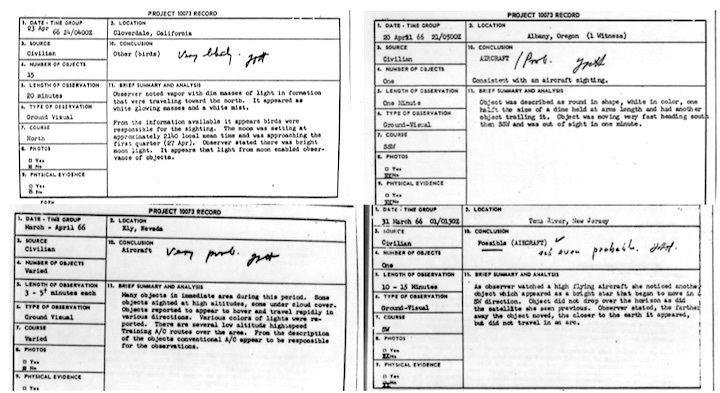
labeled as “Psychological/eccentric/imagination” between 1963 and April of 1966.
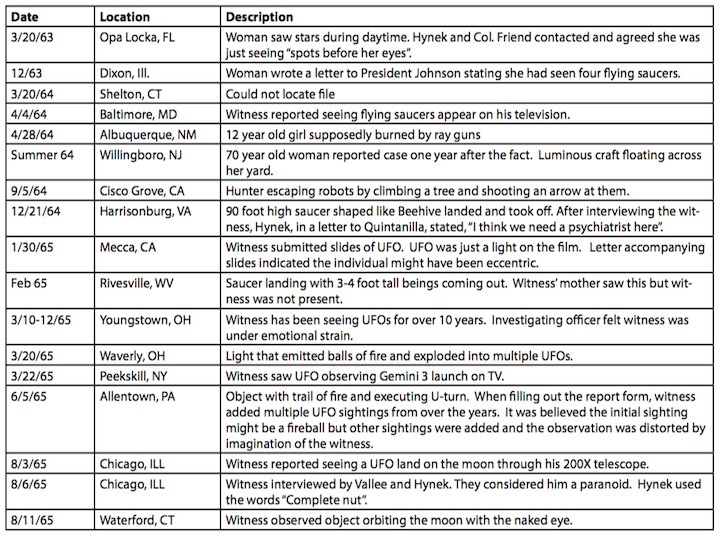

A common theme in many of these cases is that a spacecraft and/or alien beings were observed at close proximity. Based on ex- amination of these les, many of these cases can be described as “imagination” or “psychological”. I also noticed that at least two of these cases appeared in Hynek’s book, The Hynek UFO report, as examples of Close Encounters. These are the Cisco Grove and Lone Prairie cases. When describing the Cisco Grove case, Hynek described it as “hard to believe” but considered the endorsement of the witness’ story by a local astronomy instructor as important.12 When Dr. Roy Craig examined the case, during the Condon study, he seemed unimpressed and implied that the witness may not have been overly truthful about what transpired.13 As for the Lone Prairie case, I would consider it also hard to believe. The supporting witness testimony may not have been observations of the same object. They certainly did not see the creatures or physical craft the witness reported. Looking at these cases objectively, can we really criticize Moody for being skeptical about the witness’ mental stability?
One of the biggest charges hurled by Hynek was that Moody was going back in the records and reclassifying “a lot” of unexplained cases as “explained”. Hynek did a reevaluation of the Blue Book system back in the 1970s. He published his count of “unknowns” in “The Hynek UFO report”. While the USAF listed 701 “unknowns”, Hynek only listed 640!14 Had Moody done what Hynek stated he had done, then the number of unidenti eds should have increased signi cantly. Instead, they decreased. However, Hynek made it clear it was the 1950s time frame, where Moody did his “dirty work” of “cooking the books. If we exclude 1952, Hynek did reclassify 46 more cases as unknown than Blue Book between the years 1948 and 1961. The greatest increase was 1956-58 (61 vice 38 for BB) Were these 23 extra cases the ones that Moody “ xed” or were they just cases that those present at Blue Book did not classify to Hynek’s liking? Without a detailed account of what cases these were, it is hard to say. However, we can look at the case les and see if there were any changes over the years and what cases were changed.
I focused my attention on the years 1956-8. Interestingly, the number of unknowns changed between 1959 and 1963 before Moody was assigned:

In mid-1964 the USAF started using a new card (FTD Form Sep 63 0-329) for their case les. The previous forms found in the Blue Book les were ATIC form 329 (Rev 26 Sept 52) and AISOP form 5 (15 Oct 54). If there was a wide-spread classi cation of cases in the 1950s as claimed, Moody would have had to write over the existing cards or he would have to replace the cards with the new versions. He could have used old cards prior to the new ones being released or used up existing stock of old cards but, for the pur- poses of examining the claim, I had to use these clues to identify the cases where Moody might have changed the classi cation. If it were widespread, as Hynek indicated, there would have been a signi cant number of cases with these conditions. For the years 1955-1959, I found the following results:

Many of the “new cards” were due to reports made by individuals a decade later in the 1960s. These cards were lled out and placed into the system. In some cases they were labeled “For information only”. Other cards may have been used to replace worn or lost cards. In any case, there were relatively few new cards in the les from the late 1950s. It is interesting to note that one of these cases reported almost a decade later made it into the “Unidenti ed” category even though the card states it should not be really classi ed as such due to the time delay.20 If Hynek’s claims were accurate, one would think Moody would have classi ed it as “insu cient in- formation” or “Psychological” . Somehow, this case got by the eagle eye of Moody and managed to make it into the list of 701 cases!
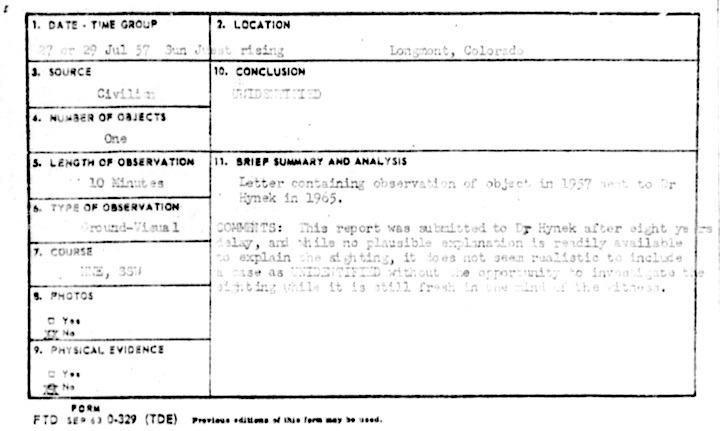
The pen and ink changes are harder to pinpoint but many of the changes I found had to do with changing one classi cation to another after further review or if new information became available. The following cases were changed from unknown to either insu cient information or identi ed between 1955 and 1959:
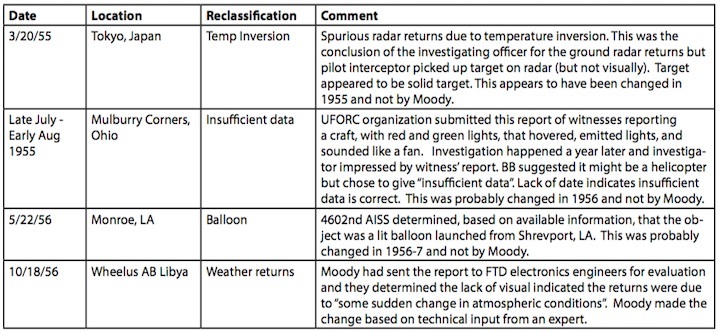
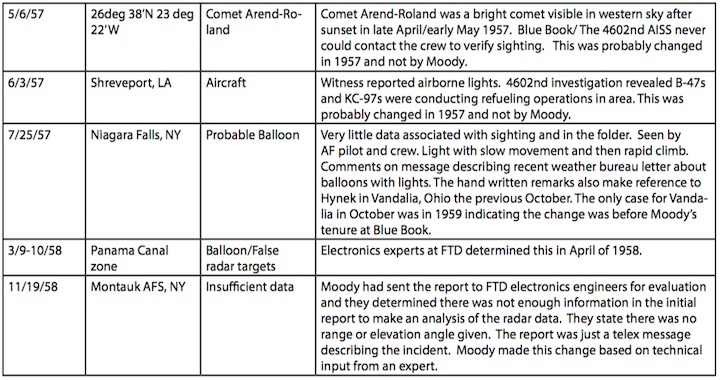
The only two cases where we have Moody’s ngerprints are when he was looking into radar cases and sent the report to FTD elec- tronics experts for analysis. Based on this information, it seems that Moody was just doing his job of evaluating old cases to see if the classi cation was correct. Instead of doing it on his own, Moody had formally requested help to evaluate these old cases. There is no indication that his e orts to alter these cases were as nefarious as Hynek tried to portray.
Hynek’s characterization of Moody may have been personal. Major Quintanilla mentioned Hynek’s complaints about Moody in his unpublished manuscript of his time at Blue Book:
He complained to me that Dave Moody was not treating him according to his scienti c stature or some crap like that. I talked to Dave about it the rst couple of times and Dave would come back that he was too busy to baby sit or kiss the Doctor’s ass and that if he would get busy and evaluate the cases that were referred to him, that he wouldn’t have time to worry about scienti c stature. Dr. Hynek and Dave had a thing going and I decided to study it. After I analyzed the situation, I had to agree with Dave. Dr. Hynek would come into the o ce and he would spend the rst couple of hours socializing or gossiping or telling us a lot of nonsense about who was writing books, articles, etc. It was during one of these distracting sessions that I raised my voice and asked Dr. Hynek to con ne his visit to case studies and let the rest of the sta proceed with their work.22
I can relate to Moody’s attitude towards Hynek. As an enlisted man, his main concern was getting the job he was assigned accom- plished. Hynek was apparently distracting him or antagonizing him with his scienti c wisdom about UFOs. During my twenty-plus years in the Navy, I had instances where I was combative with o cers because of what I perceived as their interference with me trying to accomplish my tasks. I was sometimes a bit emotional in my handling of these situations and, in retrospect, I could have handled them better than I did. I suspect that Moody’s confrontations with Hyenk were of similar nature except Hynek was not even in his chain of command. He was a civilian, whose role at Blue Book was that of a consultant. I suspect that Moody probably tolerated Hynek but felt his presence was more annoyance than assistance.
Based on all of this information, can one really consider the opinions of McDonald, Hynek and Vallee as objective? Perhaps they were biased evaluations because the personnel at Blue Book did not hold the same opinion as they did regarding UFOs and/or they did not treat them with the respect they thought they deserved.
Scientists without an ax to grind
While we have heard the claims made by Vallee, McDonald, and Hynek, we have to examine what other scienti c groups stated when they examined the Blue Book system.
The rst examination of UFO cases by a scienti c group was the Robertson panel in January 1953. While UFO proponents proclaim that this was a xed hearing, it did include some prominent scientists, who were experts in their elds and could evaluate the data as it was presented. After seeing some of the best cases that Blue Book had, they stated:
“...that reasonable explanations could be suggested for most sightings and ‘by deduction and scienti c method it could be induced (given additional data) that other cases may be explained in a similar manner...there is no evidence that the phenomena indicates a need for the revision of current scienti c concepts”23
These kinds of comments become a recurring theme in comments made by other scienti c groups, who examined the les. In Project Blue Book’s Special Report #14:
It can never be absolutely proven that “ ying saucers” do not exist. This would be true if the data obtained were to include complete sci- enti c measurements of the attributes of the each sighting, as well as complete and detailed descriptions of the objects sighted. It might be possible to demonstrate the existence of “ ying saucers” with data of the type, IF they were to exist.
Although the reports considered in this study usually did not contain scienti c measurements of the attributes of each sighting, it was possible to establish certain valid conclusions by the application of statistical methods in the treatment of the data. Scienti cally eval- uated and arranged, the data as a whole did not show any marked patterns or trends. The inaccuracies inherent in this type of data, in addition to the incompleteness of a large proportion of the reports, may have obscured any patterns or trends that otherwise would have been evident...
Therefore, on the basis of this evaluation of the information, it is considered to be highly improbable that any of the reports of unidenti- ed aerial objects examined in this study represent observations of technological developments outside the range of present-day scien- ti c knowledge.24
Before the University of Colorado’s UFO Project, there was a panel of scientists who evaluated Blue Book in order to make recom- mendations. They were referred to as the O’Brien committee. According to Quintanilla, they were allowed to review any records that were in the Blue Book les. The six members did review records, interview project personnel, and spent some time questioning Quintanilla. Unlike McDonald, their review did not appear to indicate that the case les contained cases that proved aliens were visiting earth. Instead, the committee wrote the following about the “unidenti ed cases” and if they indicated something exotic:
Although abut 6% (646) of all sightings (10,147) in the years 1947 through 1965 are listed by the Air Force as “Unidenti ed”, it appears to the Committee that most of the cases so listed are simply those in which the information available does not provide an adequate basis for analysis....In 19 years and more than 10,000 sightings recorded and classi ed, there appears to be no veri ed and fully satisfactory evidence of any case that is clearly outside the framework of presently known science and technology. The committed did criticize the classi cation of cases but not for the reasons cited by many UFO proponents....some of the case records which the Committee looked at that were listed as “identi ed” were sightings where the evidence collected was too meager or too inde nite to permit positive listing in the identi ed category.
Again, we get the comment that these reports did not indicate anything “unknown to science” was being seen. Additionally, their assessment of Blue Book implied that a signi cant number of “identi ed” and “unidenti ed” cases might fall into the “insu cient information” category. There just was not enough data in most of the reports to make an accurate assessment of what was seen.
What is an “unknown”?
When it comes to evaluating Blue Book, the arguments usually come down to the cases that were listed as “unknown/unex- plained”. Exactly what fell into this category was described by Ruppelt:
If the report contains a relatively good amount of data, it is then checked against the location of known objects, phenomena, etc. If none of these explain the sighting, it is classed as unknown.26
Quintanilla gave a similar de nition:
A sighting was considered UNIDENTIFIED when a report apparently contained all the data necessary to suggest a valid hypothesis, but its description could not be correlated with any known object or phenomenon.27
Some UFOlogists have taken a di erent approach than Blue Book. They consider cases with probable and possible explanations as not explained and, therefore, they are also “unknowns”:
According to Ruppelt the percentage of Unknowns was 26.94%. A scienti c approach to these gures shows that only 11.21% were actu- ally proven explained (total of column 1 which represents 179 cases) leaving, in actuality, 88.79% unexplained! These Blue Book gures (during the most serious time of it’s life) were based on the then 1,593 sightings the Air Force had studied.
The Condon study disagreed with this mentality that possible and probable explanations are the same as “unknown”. They stated that if an incident can be “plausibly explained”29, then the solution can be accepted. The Robertson panel also suggested the same approach when they mentioned “reasonable explanations” can be used to classify UFO sightings.
UFO proponents often have problems with any “reasonable/plausible explanation” for a UFO case. They will insist that any expla- nation must explain every detail associated with the case even though some of those details may be inaccurate. If UFO reports have taught us anything is that people make mistakes about their observations and these mistakes can hide the source of the UFO sighting. The use of possible or probable explanations seem justi ed as long as there is no good reason to reject that explanation. To put it another way, “If it acts like a balloon and looks like a balloon, it probably is a balloon”.
How many?
The desire to in ate the number of “unknowns” seems to have been a goal of many UFOlogists. They collect UFO cases like they are trading cards or postage stamps and appear to be interested in quantity over quality. In an e ort to make it appear Blue Book was completely incompetent, they claim that there are thousands of “unidenti eds”. This is all based on the statement of Dr. James McDonald,:
The leading alternative to the extraterrestrial hypothesis is that of “misidenti ed natural phenomena,” viewed in terms broad enough to include conventional aircraft, satellites, balloons. The Bluebook position has for years been that UFOs are almost entirely such misiden- ti eds, and Bluebook has repeatedly asserted that their small percentage of unidenti eds would fall into that category if more adequate data were at hand. After studying hundreds of their cases, I do not agree. I say instead that adequate and open-minded scrutiny of the roughly 12,000 cases now on le at Air Force Project Bluebook would probably raise the percentage of unidenti eds from the currently acknowledged few per cent to perhaps 30-40 per cent. 31
While McDonald’s thoroughness is well known, one wonders how he could make this statement without providing evidence of how he arrived at this number. It appears to be more opinion than fact. UFOlogist Brad Sparks thinks the value is a number that McDon- ald arrived at through some form of statistical analysis:
Much more disturbing are the indications from my incomplete review of BB cases that there may be as many as possibly 4,000 Unex- plained UFO cases miscategorized as IFO’s in the BB les. McDonald similarly stated in 1968 at his CASI lecture that from his review of BB cases he estimated that 30-40% of 12,000 cases were Unexplained, or about 3,600 to 4,800 (round down and up to 3,000-5,000). These are mostly military cases and many involve radar. McDonald argued with Hynek on a number of occasions from 1966 onward that the number of Unknowns in the BB les was in reality “about an order of magnitude” greater than what the AF claimed (so instead of 500-600 Unidenti eds possibly as many as 5,000-6,000).
Sparks has spent a great deal of time creating his own list of unknowns. As of 2016, he had a total of 1723 cases out of the 12,618 reports (Sparks states there is something like 15,000 reports). That is only about 14% (less if we use the 15,000 cases described by Sparks). One must realize that Sparks has been working on this list for years and has yet to reach the 30-40% number. It seems that McDonald’s 30-40% is an overin ated number, which was probably meant to make headlines.
Looking at Sparks’ list, I have to think his values are almost as in ated as McDonald’s 30-40%. He lists cases that have reasonable explanations for them, has added cases that have questionable information, and used cases that have very limited data. Based on these characteristics alone, his “unknowns” do not meet the requirements Ruppelt had used to de ne an “unknown”. The key words he used were “a good amount of data” and “if no known objects/phenomena can explain the sighting”. A letter written by some- body to Blue Book a decade after the event happened or a single one or two page teletype message is not what one would consider “a good amount of data”. I also have to question any case where a single witness reports an extraordinary event with little or no con rming evidence. Padding a list with poor quality “unknowns” only hides the truly good cases with a bunch of noise.
While Sparks sees Blue Book as a gold mine of unknowns, other UFOlogists have seen it di erently. Alan Hendry stated the follow- ing about the CUFOS e ort to re-evaluate the Blue Book les:
When the Center made a case by case evaluation of the reports present in the Air Force les, only 5 per cent of them were worthy of the title ‘’UFO.” Almost all of the rest were lFOs.
It seems that how many “unknowns” there are is really based on what de nition one uses. If we stick to how Blue Book de ned it, we have to accept the value of 701 as the o cial value.
The 701
Hynek’s/CUFOS reevaluation of the Blue Book cases indicated that there were only 640 unknowns and not 701. That indicates desire to see how many of the 701 really are “unexplainable”.
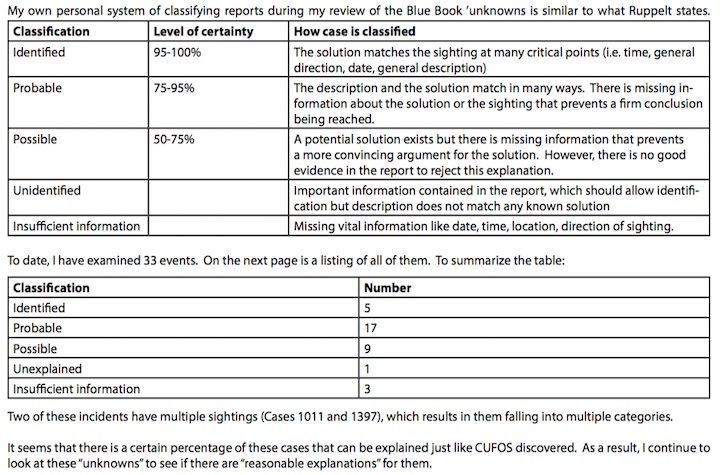
Two of these incidents have multiple sightings (Cases 1011 and 1397), which results in them falling into multiple categories.
It seems that there is a certain percentage of these cases that can be explained just like CUFOS discovered. As a result, I continue to look at these “unknowns” to see if there are “reasonable explanations” for them.
The failures of Blue Book
In my opinion, Blue book was unfairly characterized by Vallee, McDonald, and Hynek. Coupling their opinions with the NICAP agenda, there is a mythology concerning Blue Book that persists to this day. There is no doubt that personnel at Blue Book made mistakes but the harsh criticism leveled at them for doing their job, as best they saw it, is unjust. One must remember that, accord- ing to AFR 200-2, Blue Book was given the following two objectives:
The Air Force’s interest in unidenti ed ying objects is twofold: rst as a potential threat to the United States and its forces, and second, to determine the technical aspects involved.35
The technical aspects had to do with discovering some new aviation technology from these observations. At no point did it state they were supposed to perform some detailed scienti c study of the phenomenon. They did try to use all the resources they had at their disposal to identify these cases but the data being provided was the biggest problem. It is probable that, after examining so many cases of misperception, hoax, and wild stories, many of the Blue Book sta began to consider it possible that most cases could be explained. Perhaps, as Special Report 14 stated, those individuals may have become “saturated” :
The reaction, mentioned above, that after reading a few reports, the reader is convinced that “Flying saucers” are real and are some form of sinister contrivance, is very misleading. As more and more of the reports are read, the feeling that “saucers” are real fades, and is re- placed by a feeling of skepticism regarding their existence. The reader eventually reaches a point of a saturation, after which the reports contain no new information at all and are no longer of any interest.
It would not be surprising that this “saturation” e ect could have contributed to some of the mistakes that were made, which UFO proponents turned into incompetence or some form of grand conspiracy.
Despite the imperfections in the system, Blue Book did manage to properly identify a signi cant percentage of all cases and select- ed those reports they could not explain using their standards. Considering what they had to work with, I think that the sta did a reasonably good job. While their performance was not perfect, it could have been considered satisfactory.
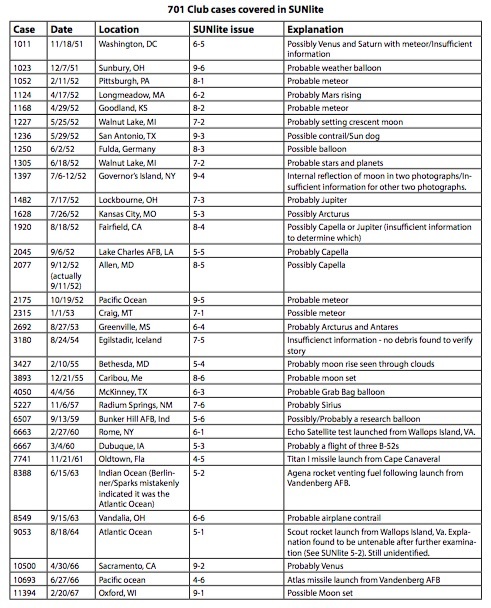
The fact that there are “unexplained/unknown” cases does not mean very much. Are these reports any better than those that state they saw Bigfoot, the Loch Ness monster, or ghosts? Probably not, which means that an “unexplained/unknown” case is nothing more than something that could not be identi ed. To suggest they are evidence of alien visitation or something unknown to science is a great leap of faith.
It’s a trap!
UFOlogists, who have been examining the Blue Book les for years, are looking for evidence to support their claim that UFOs represent something exotic or unearthly. They appear to be hoping to nd that one magic case that will prove that what they state about UFOs is true or they are trying to accumulate a plethora of cases to create the argument that “all these people can’t be wrong”. In both instances, the results are less than convincing. No single case has su cient information to eliminate the potential for misidenti cation or hoax. Meanwhile, the accumulation of a large quantity of cases invites introduction of poor quality cases that are suspect or have potential explanations. This contaminates the pool and ruins whatever argument the collection is supposed to represent. The bottom line is, other than for historical research, there is no treasure buried in the les. These reports will never provide any convincing evidence that UFOs are something unknown to science. They will only indicate that something was seen that was unidenti able. That makes them a UFOlogical trap.
Quelle: SUNlite 6/2017
